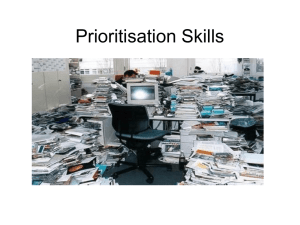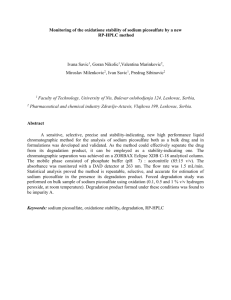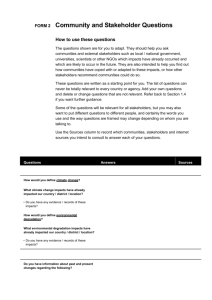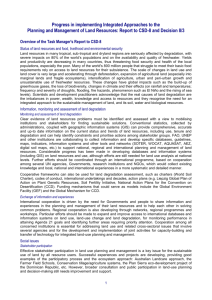GBS Review Environment 2010 Synthesis Paper on the
advertisement
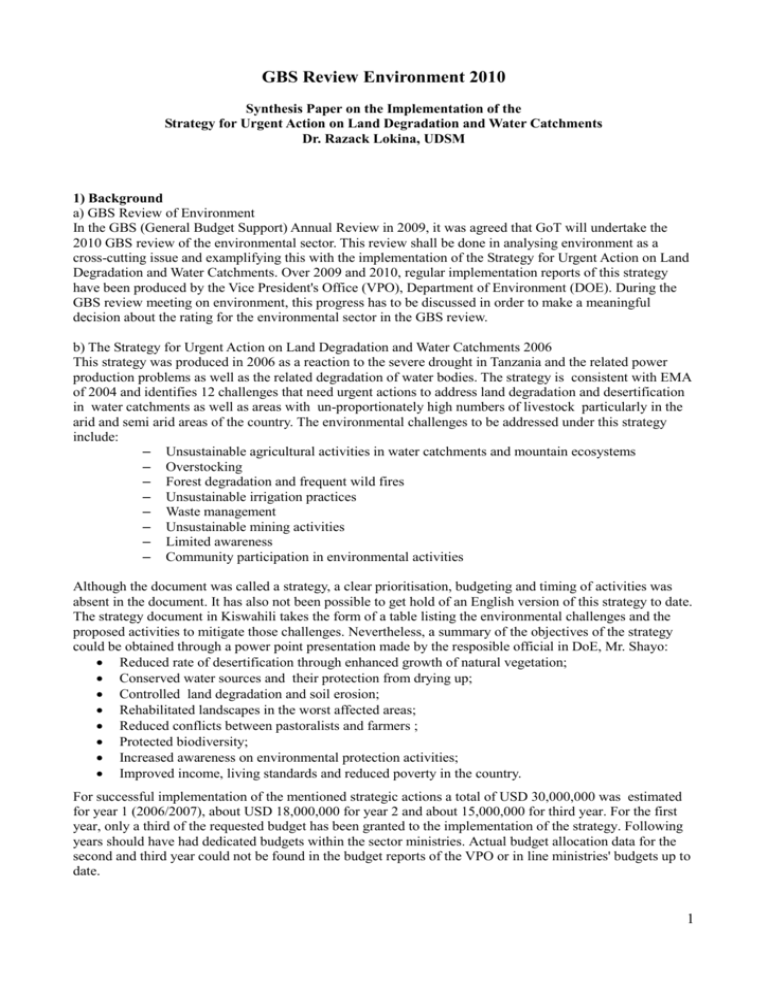
GBS Review Environment 2010 Synthesis Paper on the Implementation of the Strategy for Urgent Action on Land Degradation and Water Catchments Dr. Razack Lokina, UDSM 1) Background a) GBS Review of Environment In the GBS (General Budget Support) Annual Review in 2009, it was agreed that GoT will undertake the 2010 GBS review of the environmental sector. This review shall be done in analysing environment as a cross-cutting issue and examplifying this with the implementation of the Strategy for Urgent Action on Land Degradation and Water Catchments. Over 2009 and 2010, regular implementation reports of this strategy have been produced by the Vice President's Office (VPO), Department of Environment (DOE). During the GBS review meeting on environment, this progress has to be discussed in order to make a meaningful decision about the rating for the environmental sector in the GBS review. b) The Strategy for Urgent Action on Land Degradation and Water Catchments 2006 This strategy was produced in 2006 as a reaction to the severe drought in Tanzania and the related power production problems as well as the related degradation of water bodies. The strategy is consistent with EMA of 2004 and identifies 12 challenges that need urgent actions to address land degradation and desertification in water catchments as well as areas with un-proportionately high numbers of livestock particularly in the arid and semi arid areas of the country. The environmental challenges to be addressed under this strategy include: – Unsustainable agricultural activities in water catchments and mountain ecosystems – Overstocking – Forest degradation and frequent wild fires – Unsustainable irrigation practices – Waste management – Unsustainable mining activities – Limited awareness – Community participation in environmental activities Although the document was called a strategy, a clear prioritisation, budgeting and timing of activities was absent in the document. It has also not been possible to get hold of an English version of this strategy to date. The strategy document in Kiswahili takes the form of a table listing the environmental challenges and the proposed activities to mitigate those challenges. Nevertheless, a summary of the objectives of the strategy could be obtained through a power point presentation made by the resposible official in DoE, Mr. Shayo: Reduced rate of desertification through enhanced growth of natural vegetation; Conserved water sources and their protection from drying up; Controlled land degradation and soil erosion; Rehabilitated landscapes in the worst affected areas; Reduced conflicts between pastoralists and farmers ; Protected biodiversity; Increased awareness on environmental protection activities; Improved income, living standards and reduced poverty in the country. For successful implementation of the mentioned strategic actions a total of USD 30,000,000 was estimated for year 1 (2006/2007), about USD 18,000,000 for year 2 and about 15,000,000 for third year. For the first year, only a third of the requested budget has been granted to the implementation of the strategy. Following years should have had dedicated budgets within the sector ministries. Actual budget allocation data for the second and third year could not be found in the budget reports of the VPO or in line ministries' budgets up to date. 1 In restrospect, it can be said that the strategy was an urgent reaction to the dramatic power crisis in 2005/6 when the country failed to have a complete black-out. After the power crisis was eased by rainfall and various actions to protect wetlands and water sources, it seems that the implementation beyond those issues was perceived with less urgency. 2) Methodology Sources for the synthesis report were the annual VPO implementation report, sector ministry budget speeches, consultation with the VPO officers. Budget allocation could be partially extracted from the MTEF. Furthermore, a source for this paper was the presentation of Mr. Shayo, VPO DoE. 3) Summary of results: The interpretation if the objectives of the strategy have been met, is difficult at this stage. This is partly due to the design and formulation of the strategy itself. For example, there is no prioritisation suggested in strategy, no target setting, no clear timing and budgeting of each and every action proposed in the strategy. There was also no baseline and no quantifiable targets set in the strategy. So, the term „strategy“ is not actually the right description of this document. The objectives of the strategy also are very broad, holistic and long-term, they need a huge variety of actors, actions and institutional co-operation to be met which are not necessarily under the control of VPO. a) Better implementation results: There are areas where the strategy implementation report has registered some tangible results. These include the relocation of livestock keepers who had invaded the catchments areas and also a relocation of people who had their settlements in the mountains slopes. Different examples can be given to illustrate the better implementation results: Livestock management: – About 344,511 heads of cattle, 134,317 goats and 102,023 sheep were removed from Ihefu wetland and relocated in other parts of the country such as Lindi, Kilwa etc. – About 16,241 heads of cattle, 1,432 goats and 1,445 sheep were relocated from Kilombero valley – About 49,548 livestock that had illegally entered Kagera region from Rwanda and Burundi were evicted – In other places such as Siha, Rombo, Loliondo, joint committees with neighboring countries were formed to control unauthorised movements of livestock – about 3,000km of stock routes were rehabilitated – about 90 night camps and holding grounds were also rehabilitated. Tree planting campaign – All Local Government Authorities are implementing the National Tree planting Campaign which requires each district to plant 1.5 million trees annually. – In line with this, some District Councils have set specific trees planting targets with households, schools and institutions. Land-use conflicts and planning – To reduce the number of land-use conflicts between various users of land, a total of 5,890 village boundaries have been surveyed and demarcated country-wide – In addition to this, land use plans have been prepared for 705 villages in 48 districts since 2006 CAUTION: It is not clear from the implementation reports how the success can be measured against a baseline or how it can be proven that the success is a direct consequence of the implementation of the strategy. 2 b) Weaker implementation results Some of the planned strategic actions did not show a great success. There are many reasons for this, the insufficient funding certainly contributing. For example did the ministry of Water and Irrigation receive funding only during the first year of the strategy only i.e. 2006/07. Most of the achievements were therefore noted during the first year. The implementation in subsequent years were mainly done with funds from userfee collections. More challenged fiels of implementing the strategy were for example: Irrigation – Abstraction of more water than required – Low levels of understanding and awareness on proper water and land use – Lack of modern canal intakes with control gates – Majority of the irrigation schemes lack drain canals, and where present, they are not cleaned – Canals and other structures are not regularly maintained Solid Waste Management – Ban on the use, production and importation of Plastic bags under 30 micron. – In addition to this, the Government prepared a National Strategy on Solid Waste Management in 2008 aimed at management of solid wastes including plastics. – Some industries have started recycling plastic waste to manufacture other products. – But there is weak enforcement and failure enforce the regulation adequately. Degradation of Forest – Weak enforcement of by-laws to control wild fires and forest degradation – Continuous production of charcoal from unsustainable forest resources – Illegal logging to produce building poles – Pressure on forest areas through illegal mining activities CAUTION: It is not clear from the implementation reports how the success or failures can be measured against a baseline or how the less promising implementation results are linked to either external drivers or to challenges within the strategy. 4) Overarching reported challenges from the implementation reports: The implementation reports mentioned several challenges that were cutting across most of the implemented actions. These were: Unsufficient funding allocation (only 30% of the needed budget during the first year) Poor enforcement of the regulation Limited awareness (population but also local implementing agencies) Reporting (no quantifiable data, limited data) Prioritisation of actions (of implementation) Absence of comprehensive land-use plans 5) Overarching challenges to make statements about the implementation progress Strategy formulations: The strategy was not formulated like a strategy, not enough data on baseline, no prioritisation or timing available to monitor progress against. Reporting quality: The reporting of implementation is based on single examples, does not give statistical data, does not make statements that are quantifiable. Monitoring framework: There seems not to be an overarching implementation or monitoring framework with smart indicators to make statements on progress. Suggestion: It is therefore proposed for the 2010 review to potentially look at the implementation so far as a 3 „starting point“ only for meeting the objectives of the strategy. The future review should be guided by clear prioritisation, budgeting and timing of actions of the strategy to be implemented as well as a monitoring framework including smart indicators. 6) Suggested issues to be discussed in Review Meeting: The following 5 issues are proposed to the GBS Review Group for further discussion in order to enable a rating given to the environmental sector: a) Prioritisation How have the actions been prioritised, given the substantial reduction of funding allocated to the implementation? Awareness, motivation, mobilisation? Shared funding prioritisation between sectors and different implementing agencies? b) Is the strategy a key instrument to improve water resources management ? Wetland recovery? Protection of watersheds, water towers? c) Is the strategy the right instrument to address the issue of land degradation? Forest degradation? Charcoal production? Land degradation through mining? d) How did the strategy implementation impact on poverty? Re-settlement of livestock? Re-settlement of villages? Closing of artisanal mines? Awareness of environmental issues and their link to poverty? e) How did the implementation of the strategy impact on the issue of land-use? Land-use conflicts? Land-use planning? 4
